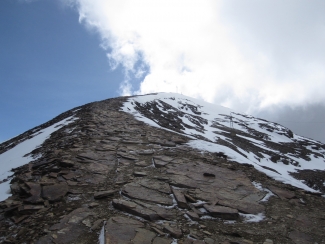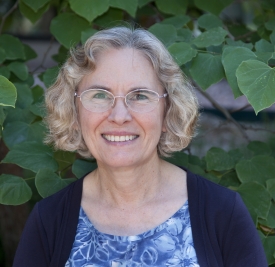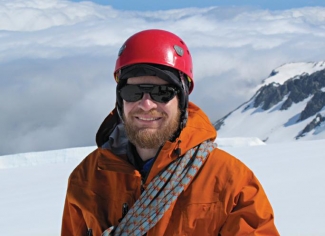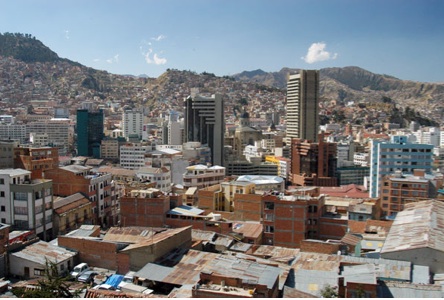Who needs glaciers?
Researchers aim to pin down their role and fate
Aug 13, 2012 - by Staff
Aug 13, 2012 - by Staff
August 13, 2012 | The Andean nation of Bolivia doesn’t have a very large carbon footprint. The country covers an area the size of Texas and California combined, yet. it’s home to fewer than 11 million people, most of whom are subsistence farmers. But Bolivia is already experiencing the effects of climate change as its glaciers shrink, putting water supplies at risk.

Though the ski lift remains, the glacier that provided decades of skiing atop Bolivia's Chacaltaya peak disappeared in 2009, succeeded only by snowfalls such as this one in early 2011. (Wikimedia Commons image by DiverDave.)
“Bolivia is a pretty dry place,” says NCAR scientist David Yates. The slow decline of the glaciers there is a concern because, as Yates points out, these storehouses of ice supply about 20 percent of the water used by major Bolivian cities such as La Paz and Santa Cruz.
It’s not yet clear how Bolivia will adapt to the gradual loss of its glaciers, but Yates’ work on water planning will help that nation determine its response. Yates is part of a team based at the Stockholm Environment Institute that’s developed an interdisciplinary model called WEAP to help cities and regions evaluate their water resources and plan for the future. “By incorporating a glacier model into our water planning model,” he says, “we’re able to answer questions like, What is the reliability of these glacial resources over the next 50 to 100 years? and What kind of investments can be made now to secure the water supply in the future?”

NCAR's Kathleen Miller specializes in multidisciplinary topics, including the evolving nature of water management in the context of a varying climate. (©UCAR. Photo by Carlye Calvin.)
Bolivia is one of many nations around the world where people depend on glaciers for fresh water. Most of the world’s ice is locked in the vast sheets of Greenland and Antarctica; it’s the smaller glaciers in the midlatitudes and tropics that provide water for people. This is where global ice is melting the most quickly, and the situation is drawing increased concern from policymakers and researchers alike.
“Everybody will need to understand what risks they face in their particular localities,” says NCAR’s Kathleen Miller, an economist who specializes in climate issues.
In contrast to the vast, remote ice sheets near the poles, mountain glaciers that provide water for human populations are especially sensitive to warming temperatures. At high elevations, where the air is generally colder, glaciers gain mass from falling snow. At lower elevations, where temperatures are warmer, glaciers lose mass through melting, which provides water used by glacier-dependent areas. This balance of gain versus loss changes throughout the year, as patterns of precipitation and temperature change. However, as a rule, a glacier is stable when snow and melt are equal. A small change in temperature can easily alter this balance and push a glacier into shrinking mode. Warmer air can also turn ice directly from frozen to vapor form without melting, a process called sublimation.
In line with the measured warming of the global atmosphere, most of the world’s glaciers have been losing mass on average for the last century or so, with the pace quickening over the last couple of decades. That trend is expected to continue with increasing concentrations of greenhouse gases and continued warming. Given these trends, says glaciologist Richard Alley (Pennsylvania State University), “we have high confidence that there will be a whole lot of glacier loss.”

One of the world's most prominent glaciologists is Richard Alley, based at Pennsylvania State University. (Image courtesy Oregon State University.)
But there are many unknowns when it comes to the details of glacier science. Specialists are trying to get a handle on how fast glaciers will disappear, which ones will go first, and how that will affect water supplies. It’s often not even clear exactly what fraction of the water used by societies is drawn from glaciers, both on the global and local scale, although in South America alone, millions of people are believed to rely in part on glacial water. For any given location, “glaciers aren’t the only source of water,” Miller explains. “Annual precipitation is often the primary source, while glacial melt becomes important during drought years and in late summer, after the annual snow pack has melted.”
Glacier science is made even more difficult because not all glaciers act the same. They inhabit different locations, with different topographies beneath them and different climates surrounding them. And while climate change will lead to generally higher temperatures around the globe, it is far more difficult to predict the range of local temperature variability, and changes in precipitation can be even more challenging to project. Some glaciers may actually grow if they receive more snow than they do now, despite rising temperatures.
That uncertainty and variation have often led to misinformation about the future of glaciers, particularly in the media. “A lot of the confusion that’s come up in the last several years is largely from generalizations,” says glaciologist Richard Armstrong (University of Colorado Boulder), who studies Himalayan glaciers. In this region alone, he points out, “there’s huge variability from east to west.” On the Tibetan plateau, for example, scientists have documented a recession of the glaciers that feed the Yangtze River in China. However, glaciers in the Karakoram Mountains along the Pakistan-China border grew slightly between 2000 and 2008.
There’s a similar east-west contrast in how people use glacial water from the Himalayas, according to Armstrong. River basins in the east, such as the Ganges, are dominated by monsoons, and glaciers supply only about five percent or less of the water used there. Further west, in the mountains of Pakistan and Afghanistan, perhaps as much as half of the water supply comes from glaciers.
As a whole, the Himalayas are losing ice, although not nearly as fast as stated in the Intergovernmental Panel on Climate Change’s Fourth Assessment Report in 2007. The report included a claim that failed to meet the IPCC’s requirements for scientific peer review. Based on a single magazine interview, the erroneous claim asserted that Himalayan glaciers would disappear by 2035. When the error and its source were identified, the IPCC issued a retraction. In that statement, the panel stressed that the findings in its overarching synthesis report remained valid: “Widespread mass losses from glaciers and reductions in snow cover over recent decades are projected to accelerate throughout the 21st century. . . . This conclusion is robust, appropriate, and entirely consistent with the underlying science and the broader IPCC assessment.”

Despite some decade-to-decade variation, the amount of water trapped in the world's glaciers decreased nearly every year from 1945 to 2005. (Fig. 5.9 from Chapter 5 (PDF) of Global Glacier Changes, courtesy United Nations Environment Programme.)
As Penn State’s Alley points out, “The basic picture is: warming melts ice. Is it possible to find an exception? Yes. Do you find lots and lots of exceptions? No.”
The loss of glaciers will be felt particularly in river basins that depend heavily on them for meltwater. As glacial melt increases, it can release hundreds or thousands of years of locked-up water. The tap may flow more freely for a time in glacier-dependent communities. But in the longer run, glacial water will inevitably become less available, putting supplies for drinking, agriculture, and hydropower at risk and causing societies to consider water use more carefully.
The Andes are home to the majority of the world’s tropical glaciers, which have been melting faster than any others, as documented by Lonnie Thompson (Ohio State University) and other pioneers of tropical glaciology. Some of these low-latitude ice stores are already completely gone. The mountain of Chacaltaya in Bolivia, for example, was home to the world’s highest ski lift for half a century. But after years of loss, the Chacaltaya glacier disappeared in 2009.
According to Edson Ramírez (Universidad Mayor de San Andrés, Bolivia), it was a drop in snowfall rather than a rise in temperatures that sealed Chacaltaya’s fate. A similar process, driven by drying rather than warming, appears to be the culprit behind the loss of ice atop Mt. Kilimanjaro in Africa. Such reductions in tropical snowfall may themselves be related to large-scale warming and associated changes in atmospheric circulation, a topic of active research.

La Paz, Bolivia, is among the world’s cities most dependent on water from glaciers. (Wikimedia Commons image by Wayne McLean.)
More than skiing is at risk with the loss of Andean glaciers: the depletion may increase water costs and impair local economies. Hydropower, which provides 80 percent of Peru’s energy, 50 percent of Ecuador’s and nearly all of the electricity in the Bolivian capital of La Paz, could become less available, leading to higher energy prices or rationing. The full scope of the threat is not yet known, though.
“One problem we have in the Andes is that the database we work with is very, very poor,” says climate scientist Mathias Vuille (University of Albany, State University of New York). “There are not enough weather stations in the region, and there has not been a good maintenance of these stations.” Andean nations tend to be poor and lack their own scientists, and many have undergone social upheaval that has interfered with glacial studies.
The research now taking place in Andean nations will help to guide adaptations to the loss of glacier-based water supplies. The project that NCAR’s Yates is working on in Bolivia, for example, will inform the Inter-American Development Bank on how to invest in infrastructure projects, such as reservoirs, watershed management, and reforestation, so that money is wisely invested. “If there’s no water to fill a reservoir, you’ve just spent a bunch of money, probably had environmental impacts, and put a reservoir in a place where it won’t meet its objectives,” Yates says.
Glacier modeling, too, will aid in better assessments. The task of modeling glaciers in large numbers has been made much easier by the release earlier this year of the National Snow and Ice Data Center’s Randolph Glacier Inventory, which provides surface areas for most of the world’s estimated 160,000 glaciers as well as the locations for many of the world’s smaller glaciers and ice caps. With this in hand, scientists can compensate for many of the variations and unknowns in glacier science. For example, with a solid estimate of global glacier surface areas, scientists can estimate the volume of ice contained in these ice masses, and potentially model changes to this volume using climate models.
“Glacier ice is a viscous fluid, and we know how it operates,” says Jeremy Fyke, a glacier modeler doing postdoctoral research at Los Alamos National Laboratory. “If you pour pancake batter onto a surface, you can generally figure out how thick that pancake is if you look at its area. It’s sort of the same thing with glaciers.”
But modelers say they would still benefit from knowing more about the topography of the bedrock beneath glaciers and about the climate surrounding them. “A lot of these glaciers are in remote places,” Fyke notes. “They’re not cheap places to go and take measurements.” Some measurements can be taken from space—the glacier inventory, for instance, primarily used data from NASA’s Terra satellite—“but that’s sometimes inadequate,” Fyke says.
“The science is improving every year, but local changes in precipitation and resulting changes in water supplies and glacier mass-balance can’t be known yet,” says NCAR’s Miller. However, she adds, that need not stop the process of preparing for a reduced water supply from glaciers. “Trying to develop a contingency planning approach will help nations respond well to any change that manifests itself.”
Sarah Zielinski is a freelance writer based in Washington, D.C.